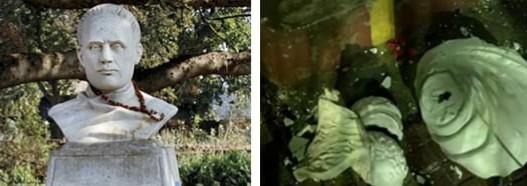
Streets of North Kolkata turned into battlefields as clashes took place during a roadshow led by Bharatiya Janata Party (BJP) president, even as police remained a mute spectator.
In one of the most unfortunate attacks on the soul of West Bengal, the bust of Pandit Ishwar Chandra Vidyasagar, one of the pioneers of the Bengal Renaissance Movement was vandalised allegedly by the saffron brigade.
Shah’s roadshow turned violent after once some Trinamool Congress (TMC) activists were seen standing with placards written “Amit Shah Go Back”. Earlier, in front of the gate of Calcutta University, too black flags were shown to Shah, after which Rashtriya Swayamsevak Sangh activists turned violent.
Later, the RSS brigade accompanying the BJP president, seeing the placard of “Amit Shah Go Back” entered the Vidyasagar College in North Kolkata and ransacked the premises, and vandalied the bust of Pandit Vidyasagar situated in the college premises.
As per video grabs, the bust was uprooted and smashed it with rods, an unthinkable act in the history of Bengal, with the aberration of the 1970s decade of violence in the state. Several motorbikes parked inside the college, belonging to students, were reportedly set ablaze by the RSS hoodlums. Of late, the TMC and BJP, in order to grab eyeballs and whip up ‘competitive communalism’, have been regularly engaging in such street battles with each other.

The questions that many people are raising is: What is happening in Bengal? Where are our intellectuals? Will there be no protests as stalwarts like Anandashankar Roy and Prof Sukumar Sen are not there now?
A teary-eyed retired professor of Physics of Vidyasagar College, Prof Asit Ghosh, told this correspondent in Kolkata that the people who vandalized Vidyasagar’s bust were a “black spot” in the state’s history. At a time when the iconic social reformer’s 200thBirth Anniversary is approaching, “this kind of hooliganism and vandalisation as a result of the mock fight between RSS-TMC, is the last nail in our patience,” he said.
He recalled that on the one hand, permission was not granted by the Kolkata Police for a rally in Kankurgachi, North Kolkata, by Communist Party of India (Marxist) general secretary, Sitaram Yechury , as the West Bengal chief minister’s roadshow was to cross that area, but on the other hand, the police was nowhere when Tuesday’s vandalism took place. “Where was the police when the bust of Vidyasagar was being vandalised”? Ghosh said.
The anguished professor said in his three decades of teaching life, “the Vidyasagar bust was endearing and a source of constant inspiration” for him. He recalled that in the 1970s, the “forces of anarchy broke the bust of Vidyasagar and Tagore and got excommunicated from Bengal’s society,” adding that “this time, too, we all should come forward to teach these saffron headgears a befitting lesson”.
Speaking on behalf of the Vidyasagar Foundation in Kolkata, its president Anandadeb Mukherjee, and secretary Anup Sarkar, in a strongly worded condemnation, said “these communal, barbarian forces, oblivious of Bengal and India’s culture, should not be tolerated even for a second.”
They alleged that “the same forces which had demolished revolutionary Bengali youth Icon and poet Sukanta Bhattacharya’s statue in Tripura, are responsible for this heinous attack, not only on Vidyasagar’s enduring legacy, but also on Bengal’s consciousness. We are demanding immediate arrest of the culprits and the perpetrators and are seeking police permission to hold a demonstration against this heinous act, as the election code is in force in the city… which is set to vote on May 19”.
Pandit Vidyasagar, a highly acclaimed social reformer and the pioneer of Bengali language, is a highly revered figure in the country, especially in Bengal. He is considered to be a liberator because of his role against societal oppression, especially of women. During his lifetime and after his death, too, he earned the wrath of orthodox Hindu fanatics and RSS considers him a prime source of rationalising and mobilising society against the then prevalent orthodox brahminical faith and incubating the radical concepts of gender equality, girls’ education, anti-caste feelings, literacy for all and widow remarriage.




